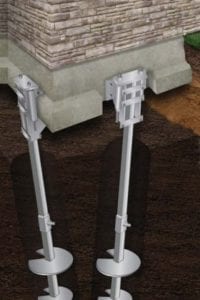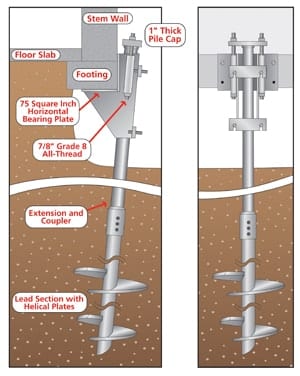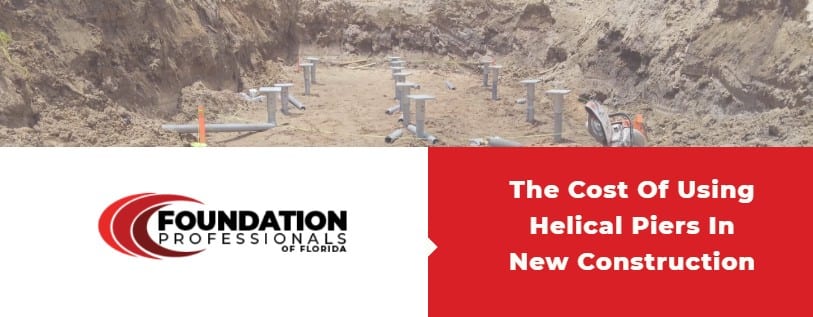There’s a reason helical piers (also known as helical piles or screw piles) are often the first choice when it comes to building foundations in new construction projects. They’re easy to install, cost-effective, and eco-friendly. They have a wide variety of applications and can be used to easily and quickly construct foundations for most residential, commercial, and industrial structures.
What are helical piers?
Helical piers are used for two main reasons: to build foundations for various types of new construction projects and to raise sinking foundations. They get their name from the fact that the steel shaft resembles a helix. They’re sometimes referred to as “screw piles” because they resemble screws and they’re screwed deep into the soil to the required depth via a high torque motor. How far into the soil they go depends on a variety of factors including the building’s design load and the soil.
Helical piers are good for building foundations on top of soil that’s less than ideal (i.e. sandy soil) and where a traditional foundation just isn’t the right choice. Their job is to take the weight of the structure and transfer it stable, load-bearing soil deep within the earth. Because they don’t require deep, expensive excavations they’re cost-effective and faster to install.
Helical piers are designed to last as long as the structure they support. They can easily last for over 100 years depending on soil conditions.

Two helical piers installed under a foundation.
How do helical piers work?
Helical piers are used for both new construction and for underpinning (i.e. lifting up) sinking structures. In both cases, their job is to provide foundation support by transferring the structure’s weight to stable, load-bearing soil. When used for underpinning, the piers are installed to depth then hydraulic jacks are used to lift the building up to its original position.
As we mentioned above, it doesn’t take very long to install helical piers. Without much preparation, a dozen or more piers can be installed in just a few hours. This makes them a cost-effective foundation solution.
The piers are screwed into the soil – to depths of 10 to 100 feet – until the desired load capacity is reached. A structural engineer will determine how many piers are required based on the size and type of the structure, number of stories, type of soil, etc. The spacing of the piers is also important and depends on the size of the structure and the type of foundation being built.

A close-up look at a helical pier.
How much do helical piers cost to install?
The cost of using helical piers in new construction depends upon a variety of factors including the level of support required and the type of soil. Because of this, it’s impossible to give you a specific price here in this blog post. For an accurate estimate of the cost of using helical piers in new construction you’ll need to contact a foundation professional who will take into account things like…
- Your geographical location. According to a report issued in 2016 by Helical Pile World, the cost for helical piles depends on where you live.
- The specific project. It costs twice as much (or even more) to repair a damaged structure using helical piles than it does to use helical piles to build new foundations.
- The number and type of piles required and whether they’ll be installed with grout or not. This depends on the type of structure, weight, footprint, etc. Piles are either round or square and come in a variety of diameters. Larger piles are more expensive.
- The depth of the installation. Piers that need to be installed at greater depths take more time and manpower.
- The type of soil – The type, size, and number of piles used depend on the soil. For example, if there’s liquefaction or the soil is especially dense, it will increase the cost of the installation.
Learn more about – Pier and beam foundation repair.
Helical piers are used for a variety of applications in residential, commercial, and industrial structures. They can be used in virtually all types of soil and geographical locations. They’re practical, cost-effective, quick to install, and last a long time. In short, they get the job done right with minimal effort and cost.
For more information about using helical piers for a new construction project or to lift a sinking foundation, contact us today.

